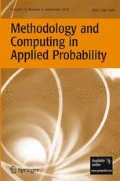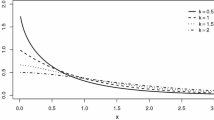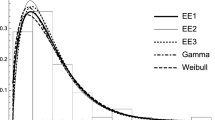Abstract
In this paper we prove a recursive identity for the cumulative distribution function of a linear combination of independent exponential random variables. The result is then extended to probability density function, expected value of functions of a linear combination of independent exponential random variables, and other functions. Our goal is on the exact and approximate calculation of the above mentioned functions and expected values. We study this computational problem from different views, namely as a Hermite interpolation problem, and as a matrix function evaluation problem. Examples are presented to illustrate the applicability and performance of the methods.
Similar content being viewed by others
References
Amari SV, Misra RB (1997) Closed-form expressions for distribution of sum of exponential random variables. IEEE Trans Reliab 46:519–522
Anjum B, Perros H (2011) Adding percentiles of Erlangian distributions. IEEE Commun Lett 15:346–348
Bekker R, Koeleman PM (2011) Scheduling admissions and reducing variability in bed demand. Health Care Manag Sci 14:237–249
Buchholz P, Kriege J, Felko I (2014) Input modeling with phase-type distributions and markov models: theory and applications. Springer, Cham
Cox DR (1962) Renewal Theory. Methuen and Co
Davies PI, Higham NJ (2003) A Schur-Parlett algorithm for computing matrix functions. SIAM J Matrix Anal Appl 25:464–485
Davis C (1973) Explicit functional calculus. Lin Alg Applic 6:193–199
Dehghan M, Hajarian M (2009) Determination of a matrix function using the divided difference method of Newton and the interpolation technique of Hermite. J Comput Appl Math 231:67–81
Descloux J (1963) Bounds for the spectral norm of functions of matrices. Numer Math 5:185–190
Favaro S, Walker SG (2010) On the distribution of sums of independent exponential random variables via Wilks’ integral representation. Acta Appl Math 109:1035–1042
Feller W (1971) An introduction to probability theory and its applications, vol II. Wiley, New York
Gershinsky M, Levine DA (1964) Aitken-hermite interpolation. JACM 11:352–356
Gertsbakh I, Neuman E, Vaisman R (2015) Monte Carlo for estimating exponential convolution. Comm Statist Simulation Comput 44:2696–2704
Goulet V, Dutang C, Maechler M, Firth D, Shapira M, Stadelmann M, expm-developers@lists.R-forge.R-project.org (2015) expm: Matrix Exponential. R package version 0.999-0. https://CRAN.R-project.org/package=expm
Higham NJ (1993) The accuracy of floating point summation. SIAM J Sci Comput 14:783–799
Higham NJ (2008) Functions of matrices: theory and computation. SIAM
Higham NJ, Al-Mohy AH (2010) Computing matrix functions. Acta Numerica 19:159–208. https://doi.org/10.1017/S0962492910000036
Jasiulewicz H, Kordecki W (2003) Convolutions of Erlang and of Pascal distributions with applications to reliability. Demonstratio Math 36:231–238
Kadri T, Smaili K (2014) The exact distribution of the ratio of two independent hypoexponential random variables. British J Math Computer Sci 4:2665–2675
Kadri T, Smaili K, Kadry S (2015) Markov modeling for reliability analysis using hypoexponential distribution. In: Kadry S, El Hami A (eds) Numerical methods for reliability and safety assessment: multiscale and multiphysics systems. Springer, Switzerland, pp 599–620
Khuong HV, Kong H-Y (2006) General expression for pdf of a sum of independent exponential random variables. IEEE Commun Lett 10:159–161
Kordecki W (1997) Reliability bounds for multistage structures with independent components. Statist Probab Lett 34:43–51
Kotz S, Kozubowski TJ, Podgórski K (2001) The laplace distribution and generalizations: a revisit with applications to communications, economics, engineering, and finance. Birkhäuser, Boston
Legros B, Jouini O (2015) A linear algebraic approach for the computation of sums of Erlang random variables. Appl Math Model 39:4971–4977
Macleod AJ (1982) A comparison of algorithms for polynomial interpolation. J Comput Appl Math 8:275–277
Maechler M (2015) Rmpfr: R MPFR - multiple precision Floating-Point reliable. R package version 0.6–0. https://CRAN.R-project.org/package=Rmpfr
Mathai AM (1982) Storage capacity of a dam with Gamma type inputs. Ann Inst Statist Math 34:591–597
Moler C, Van Loan C (2003) Nineteen dubious ways to compute the exponential of a matrix, twenty-five years later. SIAM Rev 45:3–49
Ogita T, Rump SM, Oishi S (2005) Accurate sum and dot product. SIAM J Sci Comput 26:1955–1988
Parlett BN (1976) A recurrence among the elements of functions of triangular matrices. Lin Alg Applic 14:117–121
R Core Team (2016) R: A language and environment for statistical computing. R Foundation for Statistical Computing. Vienna, Austria. https://www.R-project.org/
Ratanov N (2015) Hypo-exponential distributions and compound Poisson process with alternating parameters. Statist Probab Lett 107:71–78
Ross SM (2014) Introduction to probability models, 11th edn. Academic Press, San Diego
Scheuer EM (1988) Reliability of an m-out-of-n system when component failure induces higher failure rates in survivors. IEEE Trans Reliab 37:73–74
Shao H, Beaulieu NC (2012) An investigation of block coding for Laplacian noise. IEEE Trans Wireless Commun 11:2362–2372
Smaili K, Kadri T, Kadry S (2013) Hypoexponential distribution with different parameters. Appl Math 4:624–631
Smaili K, Kadri T, Kadry S (2014) A modified-form expressions for the hypoexponential distribution. British J Math Computer Sci 4:322–332
Van Loan CF (1975) A study of the matrix exponential. Numerical Analysis Report No. 10 Department of Mathematics. University of Manchester, England
Wen YZ, Yin CC (2014) A generalized Erlang(n) risk model with a hybrid dividend strategy (in Chinese). Sci Sin Math 44:1111–1122
Yin M -L, Angus JE, Trivedi KS (2013) Optimal preventive maintenance rate for best availability with hypo-exponential failure distribution. IEEE Trans Reliab 62:351–361
Acknowledgements
The work of the second author was done when he was with the Department of Electrical Engineering, Stanford University, USA.
Author information
Authors and Affiliations
Corresponding author
Appendix: Pseudo-Code for Computing Coefficient of H G,k(β i) for Given i:
Appendix: Pseudo-Code for Computing Coefficient of H G,k(β i) for Given i:
Let n be the size of β. Find m, the multiplicity of βiin β.
Find a which is the subvector of β with all m replications of β i removed.
Set J ← em,m.
If (m = n), return J as the vector of coefficients for (HG,1(βi),…,HG,m(βi)).
Set d ← βi.
For j = n − m downto 1, do { Set q ← 0.
For k = m downto 1, do { Set Jk ← (dJk − βiq)/(aj − βi). Set q ← Jk. }
Set d ← aj. }
Return (a1J/βi) as the vector of coefficients for (HG,1(βi),…,HG,m(βi)).
Rights and permissions
About this article
Cite this article
Li, KH., Li, C.T. Linear Combination of Independent Exponential Random Variables. Methodol Comput Appl Probab 21, 253–277 (2019). https://doi.org/10.1007/s11009-018-9653-0
Received:
Revised:
Accepted:
Published:
Issue Date:
DOI: https://doi.org/10.1007/s11009-018-9653-0
Keywords
- Affine combination
- Erlang distribution
- Hypoexponential distribution
- Hermite interpolating polynomial
- Matrix function
- Recurrence relation




